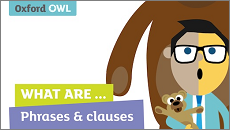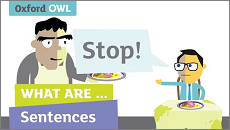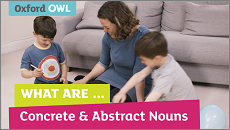Grammar & punctuation

The building blocks for written communication
The National Curriculum that children follow in English schools puts a great deal of emphasis on children understanding English grammar. At the end of primary school, every child will sit a Grammar, Punctuation and Spelling test (often called the GPS test or SPaG test). Having a good understanding of grammar is helpful for children’s writing, allowing them build words into sentences that communicate exactly what they want to say.
Thankfully, children don’t need to learn all of the theory of English grammar before they can use it to communicate – much of children’s grammar knowledge will develop naturally through listening and talking, through absorbing language from the books that they enjoy and through trying different ways of putting words together to make sentences, slowly building up an understanding of what is right and what doesn’t quite make sense.
Grammar and punctuation in the National Curriculum in England
Key Stage 1 (Years 1 and 2)
Some areas covered in Year 1 by the National Curriculum in England include:
- Combining words to make sentences
- Using capital letters, full stops, question marks and exclamation marks for different sentences
- Capital letters for names and for I when children are talking about themselves
- Turning words into their plural form using –s or –es
- Adding suffixes to verbs where no change is needed in the spelling of root words (e.g. helping, helped, helper)
- Sequencing sentences to form short narratives
In Year 2, the National Curriculum expects children to understand and use a range of different grammar and punctuation in their writing. There is an optional grammar, punctuation and spelling test that schools can choose to use to help them make an assessment about children’s understanding in these areas. Some areas covered in Year 2 by the National Curriculum in England include:
- Using capital letters, full stops, question marks and exclamation marks
- Knowing and using the four different types of sentence: statement, question, exclamation and command
- Using the present tense and past tense in their writing
- Using the progressive form of verbs in the present and past tense to show actions that are happening in the present
- Using suffixes such as –ness or –er to form nouns
- Use of the suffixes –er or –est in adjectives and the use of –ly to turn adjectives into adverbs
- Using apostrophes to mark where letters are missing in spelling and to mark singular possession in nouns
Key Stage 2 (Years 3 to 6)
In Years 3 and 4, children in English schools will continue to learn about some key features of grammar and punctuation. The expectation is that they can identify and talk about these different features when they encounter them in their reading and also use them in their writing.
The National Curriculum for Year 3 covers:
- Use of the forms a or an
- Expressing time, place and cause using conjunctions, adverbs and prepositions
- Using paragraphs as a way to group related material
- Headings and sub-headings to help present their writing
- Using the present perfect form of verbs instead of the simple past
- Using inverted commas to punctuate direct speech
The National Curriculum for Year 4 covers:
- Knowing the difference between plural and possessive –s
- Using apostrophes to mark plural possession
- Choosing to use Standard English forms for verb inflections instead of local spoken forms when writing
- Writing noun phrases expanded by the addition of modifying adjectives, nouns and preposition phrases
- Using fronted adverbials and using commas after fronted adverbials
- Use of paragraphs to organise ideas around a theme
- Making an appropriate choice of pronoun or noun within and across sentences to avoid repetition
- Using of inverted commas and other punctuation to indicate direct speech
The National Curriculum for Year 5 covers:
- Converting nouns or adjectives into verbs using suffixes such as –ate; –ise; –ify
- Using relative clauses beginning with who, which, where, when, whose, that
- Indicating degrees of possibility using adverbs or modal verbs
- Using words and phrases to build cohesion within a paragraph
- Linking ideas across paragraphs using adverbials of time, place and number or tense choices
- Using brackets, dashes or commas to indicate parenthesis
- Use of commas to clarify meaning or avoid ambiguity
By the end of Year 6, children are expected to understand and be able to use the complete range of different grammar and punctuation outlined in the National Curriculum. Children’s knowledge is assessed by a teacher assessment of children’s writing and through a grammar, punctuation and spelling test that children sit in May as part of a week of national tests.
The National Curriculum for Year 6 covers:
- Making use of the passive voice
- Knowing the difference between the language typically used in informal speech and the language appropriate for formal speech and writing
- Linking ideas across paragraphs using a wider range of cohesive devices: repetition of a word or phrase, grammatical connections and ellipsis
- Using different layout devices
- Using semi-colons, colons and dashes to mark the boundary between independent clauses
- Using colons to introduce a list and use of semi-colons within lists
- Using hyphens can be used to avoid ambiguity
Grammar and punctuation in primary schools in Scotland, Wales and Northern Ireland
- For information about grammar and punctuation in the Curriculum for Excellence in Scotland see the experiences and outcomes for literacy and English on the Education Scotland website.
- Details about grammar and punctuation in the National Curriculum for Wales can be found on the Learning Wales website.
- For information about grammar and punctuation in the Northern Ireland curriculum, see the Language and Literacy area of learning. Visit CCEA for more details.
How can I support my child’s learning?
1. Reading to your child
Years 1 and 2
While children will learn about how language works from speaking and listening, the type of language we use in writing is often different from that in speech. Reading regularly to your child, often books that they cannot yet read independently, is a great way of developing their understanding of how language works.
Years 3 to 6
Even when your child begins to read independently, reading aloud to your child, especially books that they might not be able to yet read independently, can be very important for their education. Listening to a story can help children’s reading skills to develop, building their vocabulary and developing their general knowledge. It also helps to support their writing and understanding of grammar and punctuation. While children will learn about how language works from speaking and listening, the type of language we use in writing is often different from that in speech; listening to text can give a model for the different patterns of language we use in writing.
When you are reading together, look at how authors use different sentence types for effect, such as simple sentences containing one clause (e.g. 'Sam picked up the spoon.'), short commands (e.g. 'Give me the spoon, Sam!'), or more complex sentences such as compound sentences ('Sam picked up the spoon and she ran away excitedly.') and sentences that have a subordinate clause (part of a sentence that doesn't make sense by itself, used to 'pop' in extra information about characters and situations, e.g. 'With great excitement, Sam picked up the spoon.'). Talk about different types of punctuation as well, such as question marks, exclamation marks, commas etc. Can your child identify ellipses? See how these are used to ramp up tension or to get the reader thinking.
2. Encouraging your child to read
Making time to hear your child read isn’t just good for their reading. Through frequently seeing words in print, they will have the opportunity to see how the punctuation and grammar are used to share meaning. When you read, occasionally look at the punctuation and talk about what it is telling the reader to do. Show your child how a question mark tells you to raise your voice at the end of the sentence to indicate a question being asked. Explore how you can show the 'feeling' behind an exclamation mark. Are the characters shouting, has something unexpected happened, has something gone wrong?
3. Playing games
Playing games can help children to learn about grammar and punctuation in an enjoyable way. Watch grammar expert Charlotte Raby's video 'How can I help my child with grammar, punctuation and spelling?' to see some quick and easy games in action.
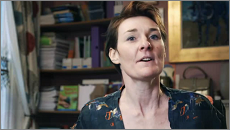
Grammar, Punctuation and Spelling made easy
Visit pageIdeas for activities and games you can play with your child to support their learning.
4. Help your child to learn some key grammar
It can be useful for children to practice some aspects of grammar and punctuation to help them understand how they work and to practice them until they have mastered the particular skill. Tried and tested resources to use at home include the following:
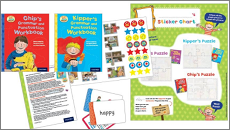
My Grammar, Punctuation and Spelling Kit
Buy on AmazonDesigned to make spelling, punctuation and grammar fun
for your child.
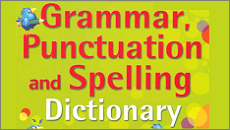
Primary Grammar, Punctuation and Spelling Dictionary
Buy on AmazonThis essential dictionary includes simple rules, tips, and examples to improve literacy skills.
